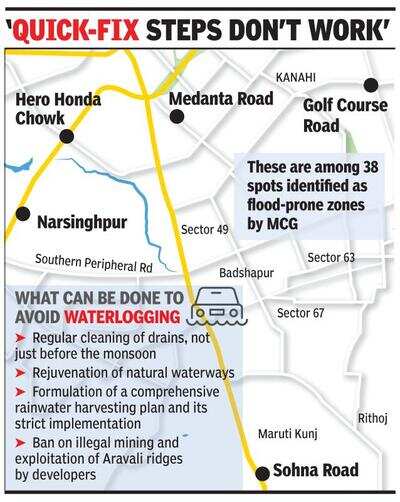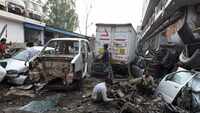
Gurgaon: A survey by the MCG has found 38 sensitive areas in the city, which are prone to flooding when it rains. Though MCG claimed it had already taken several steps, snarls and waterlogging that happened last week after showers exposed those clearly are not enough.
These 38 areas include main junctions or stretches like Hero Honda Chowk, IFFCO Chowk, Sohna road and Narsinghpur, among others. Laxity in the administration’s approach towards managing rainwater and apparent disregard towards the city’s topology in urban planning, which led to vanishing of water reservoirs and wetlands over the years, has made waterlogging a perennial problem in the city, according to experts.
Speaking to TOI, urban planners and environmentalists pointed out that occasional cleaning of drains and widening of drains among others are only quick-fixes. They also said these are being done just to show the authorities are taking measures to control flash floods — a man-made crisis.
“A problem of this magnitude needs continuous planning and implementation of a host of approaches to resolve problems in issues of drainage system and disappearance of natural waterways, which happen owing to unplanned concretisation of every piece of land,” said a city-based urban planner Mukta Naik, who lives near Sohna road. She was stuck in massive snarls caused by waterlogging after pre-monsoon showers last week.
A disaster in the making
Environmentalists and experts in urban planning and road designs claimed haphazard urbanisation with no regards to topography of the city has disturbed the ecology. Concretisation of land, drains and parks among other public spaces has made water-conservation efforts much tougher.
As several ponds and natural waterways are covered with thick layers of bitumen, steel and cement paving, the catchment areas of water have disappeared over time. Consequently, problems like waterlogging have been taking monstrous forms, which is an indication towards a disaster in the making, experts said.
“Natural waterbodies like streams, ponds, lakes and wetlands have been compromised for the sake of infrastructure development. In the blind obsession with development where valuation of land for real estate is the driving force, we’ve done great injustice to the environment. The problems like waterlogging and acute scarcity of water are man-made crises. Disregard to environment is coming back to bite us,” pointed out Prerna Singh Bindra, an environmentalist and the author of The Vanishing: India’s Wildlife Crisis.
Experts further asserted that while the 2016 deluge could have been an eye opener for the government and administration, the authorities have only been engaging in cosmetic fixes. Solution lies elsewhere, they contested
Solution lays elsewhere
Experts have asserted that unless the city takes serious and dedicated steps towards conserving every rain drop, water crisis will keep haunting residents and the administration interchangeably as deluge- like situation during monsoon and water scarcity during the rest of the year.
Naik has asserted that water management is a critical issue for the city as on one hand, the groundwater is depleting at a catastrophic rate, while on the other rainwater is being wasted. She believes that channeling rainwater to recharge the water table should be the target of the administration.
“A narrative like Swachh Bharat Mission has to be developed if we are at all serious to conserve water. There has to be a commitment from governments to civic bodies,” she said.
Reiterating Naik, Bindra also said rejuvenation of wetlands, water reservoirs and prohibition on exploitation of Aravalis should be the first step to begin with, if we are to mitigate water scarcity.
GMDA too has in its recent report, released last month, accepted that rapid urbanisation has disrupted the natural flow of water. The department has also announced its plan for comprehensive drainage system that will keep the city’s topography in mind. Budgeted at over Rs 200 crore, the project would also focus on building water harvesting structures. The project, which is expected to commence in the fiscal year 2019-20, will take around two years for completion.
These 38 areas include main junctions or stretches like Hero Honda Chowk, IFFCO Chowk, Sohna road and Narsinghpur, among others. Laxity in the administration’s approach towards managing rainwater and apparent disregard towards the city’s topology in urban planning, which led to vanishing of water reservoirs and wetlands over the years, has made waterlogging a perennial problem in the city, according to experts.
Speaking to TOI, urban planners and environmentalists pointed out that occasional cleaning of drains and widening of drains among others are only quick-fixes. They also said these are being done just to show the authorities are taking measures to control flash floods — a man-made crisis.
“A problem of this magnitude needs continuous planning and implementation of a host of approaches to resolve problems in issues of drainage system and disappearance of natural waterways, which happen owing to unplanned concretisation of every piece of land,” said a city-based urban planner Mukta Naik, who lives near Sohna road. She was stuck in massive snarls caused by waterlogging after pre-monsoon showers last week.
A disaster in the making
Environmentalists and experts in urban planning and road designs claimed haphazard urbanisation with no regards to topography of the city has disturbed the ecology. Concretisation of land, drains and parks among other public spaces has made water-conservation efforts much tougher.
As several ponds and natural waterways are covered with thick layers of bitumen, steel and cement paving, the catchment areas of water have disappeared over time. Consequently, problems like waterlogging have been taking monstrous forms, which is an indication towards a disaster in the making, experts said.
“Natural waterbodies like streams, ponds, lakes and wetlands have been compromised for the sake of infrastructure development. In the blind obsession with development where valuation of land for real estate is the driving force, we’ve done great injustice to the environment. The problems like waterlogging and acute scarcity of water are man-made crises. Disregard to environment is coming back to bite us,” pointed out Prerna Singh Bindra, an environmentalist and the author of The Vanishing: India’s Wildlife Crisis.
Experts further asserted that while the 2016 deluge could have been an eye opener for the government and administration, the authorities have only been engaging in cosmetic fixes. Solution lies elsewhere, they contested
Solution lays elsewhere
Experts have asserted that unless the city takes serious and dedicated steps towards conserving every rain drop, water crisis will keep haunting residents and the administration interchangeably as deluge- like situation during monsoon and water scarcity during the rest of the year.
Naik has asserted that water management is a critical issue for the city as on one hand, the groundwater is depleting at a catastrophic rate, while on the other rainwater is being wasted. She believes that channeling rainwater to recharge the water table should be the target of the administration.
“A narrative like Swachh Bharat Mission has to be developed if we are at all serious to conserve water. There has to be a commitment from governments to civic bodies,” she said.
Reiterating Naik, Bindra also said rejuvenation of wetlands, water reservoirs and prohibition on exploitation of Aravalis should be the first step to begin with, if we are to mitigate water scarcity.
GMDA too has in its recent report, released last month, accepted that rapid urbanisation has disrupted the natural flow of water. The department has also announced its plan for comprehensive drainage system that will keep the city’s topography in mind. Budgeted at over Rs 200 crore, the project would also focus on building water harvesting structures. The project, which is expected to commence in the fiscal year 2019-20, will take around two years for completion.
World Cup 2019
Trending Topics
LATEST VIDEOS
More from TOI
Navbharat Times
Featured Today in Travel
Quick Links
Lok Sabha Election Schedule 2019Lok Sabha Election NewsDelhi Capitals teamMI team 2019Rajasthan Royals 2019RCB team 2019Maharashtra Lok Sabha ConstituenciesBJP Candidate ListBJP List 2019 TamilnaduShiv Sena List 2019AP BJP List 2019Mamata BanerjeeBJP List 2019 MaharashtraPriyanka GandhiBJP List 2019 KarnatakaAMMK Candidate List 2019BJP List 2019 WBLok Sabha Elections in Tamil NaduBSP List 2019 UPNews in TamilLok Sabha Poll 2019Satta Matka 2018PM ModiMahagathbandhanNagpur BJP Candidate ListChandrababu NaiduTamil Nadu ElectionsUrmila MatondkarNews in TeluguMadras High CourtTejashwi YadavArvind KejriwalTejasvi SuryaPawan KalyanArvind KejriwalYogi AdityanathJaya PradaSatta King 2019Srinagar encounter
Get the app







